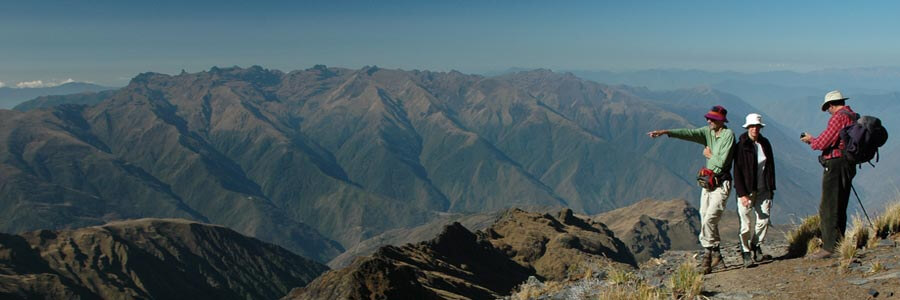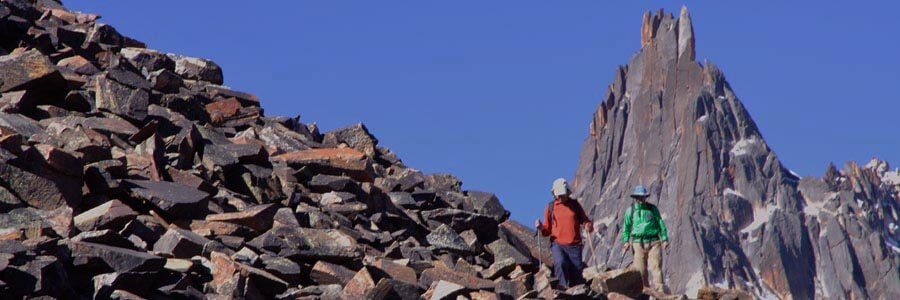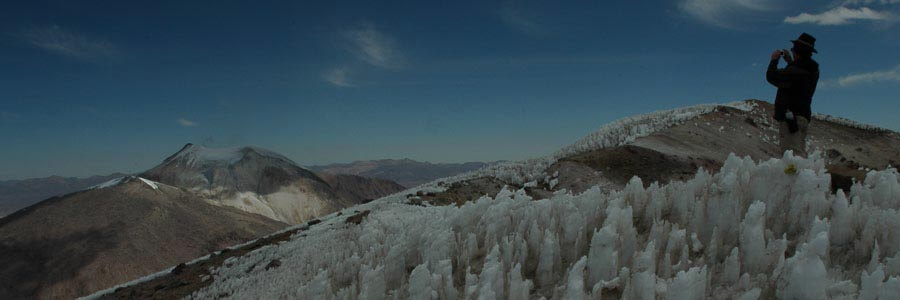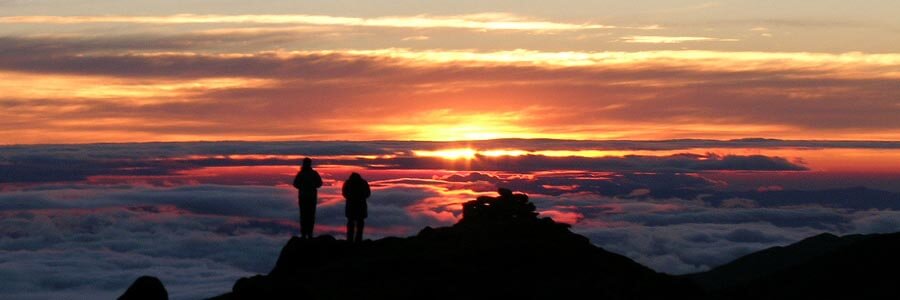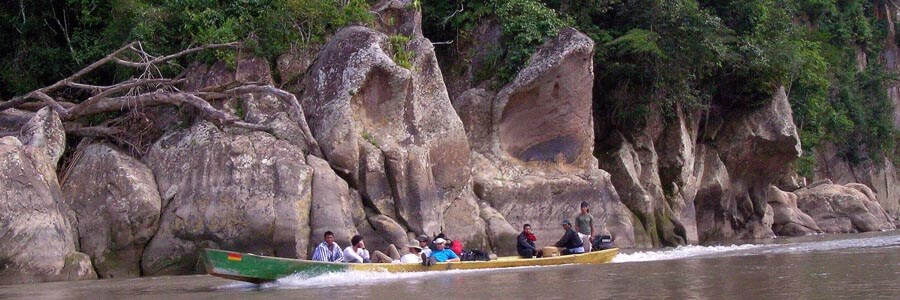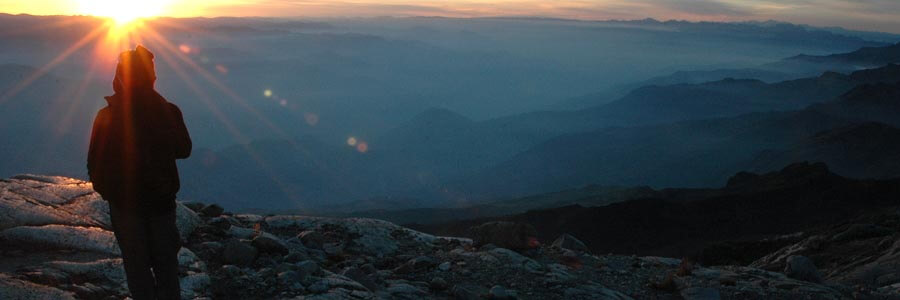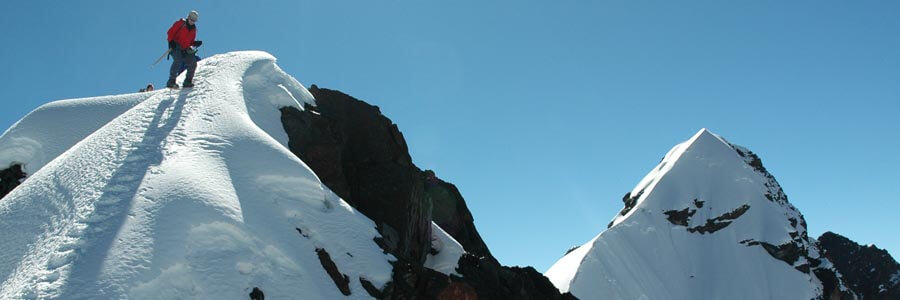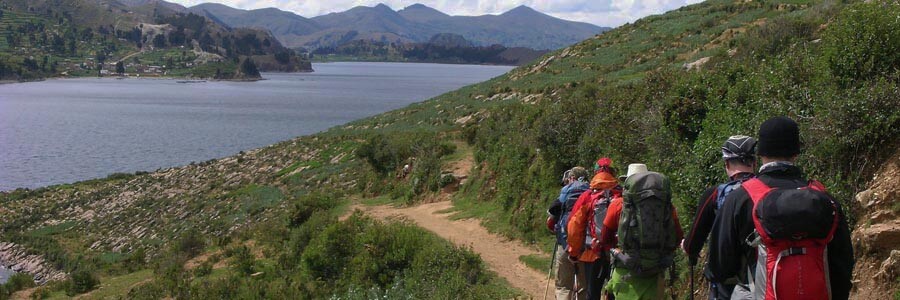Code: MSROYAL Duration: 6 days
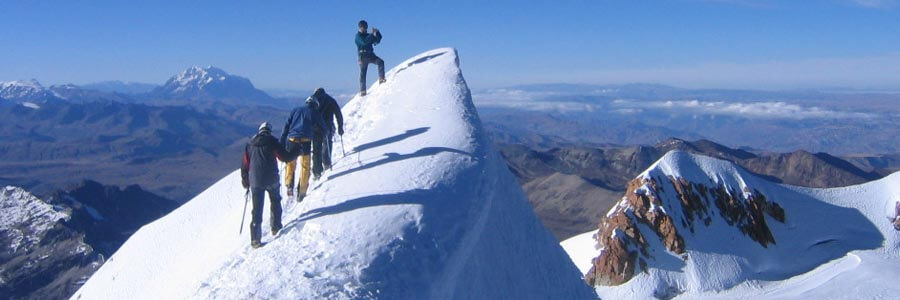
What would justify you to travel all the way to the Andes to take a climbing course and climb some mountains?.
First of all let us tell you that this is the first and only professional mountaineering school in the Andes. Our instructors have been trained either by the German Alpine Club (Deutschen Alpenvereins, DAV) or the Chamonix climbing and ski school (ENSA). As members of the Bolivian Mountain Guides Association, have got the certification of the International Mountain Guides Association (UIAGM, IMGA, IVBV).
The mountains surrounding Chachacomani and the glaciers that flow from its slopes are a great school “campus”. We will spend the first 4 days learning internationally approved mountaineering techniques in: walking in different type of terrains, rock climbing, snow and ice climbing, glacier travel and crevasse rescue techniques.
The day-by-day itinerary also includes detailed information about the instruction content, both theoretical and in the field.
Please note that to take this trip alone, you must already be acclimatized to the highlands. This means that you must have spent at least 3-5 days at the highlands doing light physical activity. For more information about this subject, please refer to the page acclimatization at our website.
We strongly suggest you to extent your trip and add an extension to climb Illimani Mountain MEILLIMA or Sajama volcano MESAJAMA.
Short Itinerary
Day 1. Transport to Janko Kota Valley. Rope work and knots. Camp
Day 2. Snow techniques. Camp
Day 3. Ice climbing techniques. Camp
Day 4. Crevasse rescue techniques practice. Camp
Day 5. Climb janko Huyo. Camp
Day 6. Climb of Apacheta. Transport to La Paz.
Highlights
- Knots and rope handle.
- Glacier travel and basic crevasse rescue techniques.
- Snow climbing techniques and self-arrest.
- Ice climbing techniques, use of crampons and ice axes.
- Splendid views of of Cordillera Real Mountains and glaciers.
- At least two summits above 5000 m.
Services Included
- Meals mentioned in the itinerary.
- 5 nights accommodation in tents.
- Full land transportation during the trip.
- Common camping equipment: 3 season tents, kitchen and mess tents, tableware.
- Common climbing equipment: ropes, carabiners, slings, snow stakes, ice screws.
- Professional bilingual UIAGM / IFMGA / IVBV certified mountain guide.
- Cook.
- National Park and community land entrance fees.
Services Not Included
- International & local flight tickets & fees.
- Transfers IN/OUT to airports.
- Meals & hotels while in La Paz.
- Personal camping equipment: sleeping bag, headlamps, and clothing.
- Personal climbing equipment: plastic boots, crampons, harnesses, ice axe.
- Insurance of any kind.
- Any expense due to a rescue operation (rescuers fee, transportation, or medical cost).
Day to day details
Early in the morning we will take the vehicle that will take us to Janko Kota valley located in the middle of Cordillera Real; there in a beautiful grassy spot near to a crystalline river we will start our acclimatization. There at the foot of Willa Llojeta peak (reddish landslide) we set up the campsite that we will use for the following 5 nights. We will learn and practice rope work and knots. BY end of the day we will learn how to navigate with maps, compass and GPS.
Overnight: Tents
El Alto: 4,100m (13,450ft)
Janko Kota Camp site: 4,750m (15,580ft)
Driving: 3Hrs (65km)
L,D
After a short hike we will get to the lower glaciers of Wila LLojeta where we will spend most of the day practicing.
Overnight: Tents
Glacier: 5,000m (16,400ft)
Walking: 5-6Hrs
B,L,D
Today again we will go to another glacier for a second practice day to learn ice climbing techniques. From walking to vertical and more!.
Overnight: Tents
Old Glacier: 5,000m (16,400ft)
Walking: 6Hrs
B,L,D
To get to the crevasses we have to climb quite high on the glaciers. The instructors will decide where to go depending on the snow conditions.
Overnight: Tents
Glacier: 5,200m (17,056ft)
Walking: 6Hrs
B,L,D
After a short drive to Mullu pass following the road that heads to Amawaya, we will start ascending over granite boulders towards a snowy ridge overlooking to a wide glacier and leading directly to the summit. The views the rest of the Royal Range and the Bolivian Highlands are just breathtaking. From the summit it is possible to view almost all the mountain range, the highlands with Lake Titicaca in the background and the valleys leading to the cloud forest; and – in clear days – as far as Sajama volcano.
Overnight: Tents
Janko Uyu: 5,512m (18,079ft)
Walking: 6-7Hrs
B,L,D
More than a practice day, we can consider today as a “fire test” for everybody. We will split the group in smaller climbing teams and each one will have to plan and solve the climb by themselves. The instructors will just supervise how climbers plan the route, choose and organize the equipment needed, discuss an emergency plan, and climb the mountain without direct help. Our route starts at Mullu pass first through moraines and loose rocks, then up to the glacier towards our summit.
We will return to Base Camp in early afternoon to brake camp ans return to La Paz.
Overnight: None
Mullu Apacheta: 5,150m (16.892ft)
La Paz: 3,650m (11,972ft)
Walking: 8-10Hrs (7km)
Driving: 1-2Hrs (45km)
B,L
- General briefing of the course.
- The process of the acclimatization to the altitude.
- The process of learning how to climb.
- Basics of the body metabolism.
- Objective and subjective dangers in the mountains.
- Camping & climbing gear (Clothing, Camping equipment, Ice & rock climbing gear).
- Safety and quality of the equipment (ropes, harnesses, protection, hardware, Karabiners, etc).
- The importance of Communication (discussion over accidents produced because miss-communication).
- How to plan a climbing expedition (Goal, Route, Difficulty, Provisions, Equipment, Personnel, and Transportation).
- Geology of the Andes
- Geography.
- Maps interpretation (Cartography).
- Roped team work.
- Ice, snow, storms, climate.
- Glaciers.
- Mountain sports training (performance capacity, technical & physical training).
- Physics: Climbing gear (ropes, harnesses, slings, carabines), Climbing system (fall impact, friction), Risk and accidents.
- Discussion and evaluation of the course (critics & self-critics).
- Walking over different types of terrain: soft soil, grass, loose stones, gravel, rock, sand (Parallel and crossed steps, Walking aids one or two walking sticks, Rest-step technique).
- Oxygen & energy management (breathing, rhythm, clothing, food).
- Personal equipment check.
- Walking on steep rock using feet and hands.
- Balance of the body, "three points" technique.
- Feet and hands position.
- Basic rock climbing, traversing.
- Basic knots and rope arts, follow through and on-a-bight if apply: (Clove Hitch or Ballestrinque, Munter Hitch or Medio Ballestrinque, Sling knot or Nudo de cinta, double Figure 8 knot or Nudo ocho, Double fisherman or Pescador, Prusik Hitch).
- Walking on ice with and without crampons, ice axe and walking stake. Practice & games (duck step, parallel & crossed steps)
- Self arrest (different: positions, type of terrain, steepness, other complications (i.e. back pack or rope).
- Cutting steps on ice.
- Cramponing techniques (French technique / German - front pointing technique)
- Ice axe techniques (support, Anchor, broom, stairs hand-rail, improvisation with a walking stick).
- Belaying short difficult passes with the belayer’s body.
- Short rope technique.
- Use of harness and Tying in (direct & indirect)
- Protection: passive, active, semi-active.
- Belaying devices (ATC, figure 8, Tuber, jaws, Grigri, Carabiner)
- Belay station built.
- Communication keywords.
- Simulacrum of the climbing procedure.
- Plan and log the route (optimal route, exit route, timing planning, land marks).
- Navigation (Use of maps, Use of the compass, Use of the altimeter, Use of the GPS).
- Rope management (Rock & ice climbing with one & two ropes, Glacier traversing optimal distance between climbers)
- Belaying on ice (top-rope and leading): screws, slings, karabiners, dynamic and static belays.
- Vertical Ice climbing practice with top-rope (Ice axe traction technique with 1 and 2 tools)
- Belaying on ice: screws, slings, karabiners, dynamic and static belays.
- Practice of learned climbing skills (Route planning, Navigation and climb, Leading on Ice).
- Rappel (alone, with an injured).
- Rope ascent (Prusik and “Jumaring”).
- Transport of injured (improvising stretchers).

